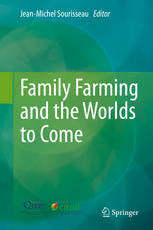
Family Farming and the Worlds to Come PDF
Preview Family Farming and the Worlds to Come
Jean-Michel Sourisseau Editor Family Farming and the Worlds to Come Family Farming and the Worlds to Come ThiSisaFMBlankPage Jean-Michel Sourisseau Editor Family Farming and the Worlds to Come Editor Jean-MichelSourisseau CIRAD Paris,France ISBN978-94-017-9357-5 ISBN978-94-017-9358-2(eBook) DOI10.1007/978-94-017-9358-2 SpringerDordrechtHeidelbergNewYorkLondon LibraryofCongressControlNumber:2014954240 E´ditionsQuæ,R10,78026Versaillescedex,Francewww.quae.com ©E´ditionsQuæ,2015 Thisworkissubjecttocopyright.AllrightsarereservedbythePublisher,whetherthewholeorpart of the material is concerned, specifically the rights of translation, reprinting, reuse of illustrations, recitation,broadcasting,reproductiononmicrofilmsorinanyotherphysicalway,andtransmissionor informationstorageandretrieval,electronicadaptation,computersoftware,orbysimilarordissimilar methodologynowknownorhereafterdeveloped.Exemptedfromthislegalreservationarebriefexcerpts inconnectionwithreviewsorscholarlyanalysisormaterialsuppliedspecificallyforthepurposeofbeing enteredandexecutedonacomputersystem,forexclusiveusebythepurchaserofthework.Duplication ofthispublicationorpartsthereofispermittedonlyundertheprovisionsoftheCopyrightLawofthe Publisher’s location, in its current version, and permission for use must always be obtained from Springer.PermissionsforusemaybeobtainedthroughRightsLinkattheCopyrightClearanceCenter. ViolationsareliabletoprosecutionundertherespectiveCopyrightLaw. The use of general descriptive names, registered names, trademarks, service marks, etc. in this publicationdoesnotimply,evenintheabsenceofaspecificstatement,thatsuchnamesareexempt fromtherelevantprotectivelawsandregulationsandthereforefreeforgeneraluse. While the advice and information in this book are believed to be true and accurate at the date of publication,neithertheauthorsnortheeditorsnorthepublishercanacceptanylegalresponsibilityfor anyerrorsoromissionsthatmaybemade.Thepublishermakesnowarranty,expressorimplied,with respecttothematerialcontainedherein. Printedonacid-freepaper SpringerispartofSpringerScience+BusinessMedia(www.springer.com) Foreword This book is most welcome in a year dedicated to family farming by the United Nations.It revisits themostcommon approachesfor analyzing andunderstanding family farming – and emphasizes, rightly so, the multiplicity of forms of family farming that do exist. It is essential to properly define this type of agriculture to better identify its issues and to place it in a larger context and thus assess its contributiontosustainableandequitabledevelopment.Ithuswelcometheinitiative taken to make family farming once again central to debates on agricultural development. Familyfarmingisindeedattheheartofworldagriculture.Theroleitplaysinthe dynamicsof land andagrarianreform is ofparamountimportance tothe transfor- mationalprojectsthatmanycountriesoftheSouthintendtoundertakeinthenext 10–20years.Atatimewhenourterritoriesandlandsarebeingreshaped,rapidand oftenunpredictablechangesrequirepopulationstoexhibitahighlevelofresilience to hazards of all kinds. Faced with these challenges, family farming is a rational choicetohelpmaintainthedelicatebalanceofeverdwindlingnaturalresourcesin order to meet the needs of a growing population. Calibrating our responses to changing daily needs so that we can preserve the legacy that we leave to future generationsremainsaglobalchallenge.Everycontinenthastomeetthischallenge, Africa especially so, given its demographic perspectives and vast agricultural potential. Thispublicationencapsulatesthreedecadesofintellectualinvestmentonavery complexsubject.Therelativelackofknowledgeaboutthetopiccanexplain–but not excuse – the perpetuation of notoriously inappropriate actions. In the African context,andthusforNEPAD,1 thereconstructionoftheconceptoffamilyfarming is a particular challenge given that competing and often pejorative concepts are used todescribeit:small-scale agriculture,subsistence farming, andpeasantagri- cultureamongothers.Byallowingustoclearlyidentifythecontours–aswellasthe 1TheNewPartnershipforAfrica’sDevelopment. v vi Foreword variability–offamilyfarmingmodels,thisbookprovidesusthemeanstounmask theideologicalunderpinningsorthelimitationsofeachoftheseconcepts.Clearly identifyingthespecificityoftheseissueswillbeanimportantfirststeptobeableto answerquestionsontheabilityoffamilyfarmingtocopewithglobalchallenges,as comparedtoothertypesofagriculture.Thisworkwillneedtobeputtothetestin real-world situations, especially in Africa, where the notion of family itself takes multipleforms. This book’s recognition of family farming as one of the main drivers of rural transformationscurrentlyunderwayanditsconvictionthatthisformoffarmingis worth promoting in many regions of the world is encouraging, especially to us in Africa.Itreinforcesourvisionofagriculturewhichaccordsmoreresponsibilityto thosewhoproducethemselves,ofanAfricaproudofitsagricultureanditsfarmers. This book presents an overview that reinforces our commitment towards constructingapluralAfricawhichassumesandhopesforabetterfuture. Thiscollaborativeworkisdecidedlyanimportant milestoneinCIRAD’slong- standing commitment to address fundamental issues for the sustainable develop- mentofachangingworld. Dr.IbrahimAssaneMayaki ExecutiveSecretary NEPADPlanningandCoordinationAgency Acknowledgments Thisbookisarealcollectiveachievement.Inadditiontotheauthorsofchaptersand boxes acknowledged atthe endofthebook,manypeoplewere involvedinit.All their contributions, whatever their shape and size, are part of the richness and the diversityofthiswork. Weexpressoursincerethanksto: JacquesAvelino,VincentBaron,HubertdeBon,MurielBonin,JulienCapelle, Alexandre Caron, Ve´ronique Chevalier, Marc Corbeels, Jean-Philippe Deguine, Ste´phanieDesvaux,SophieDevienne,Jean-MarieDouzet,Noe¨lDurand,Sandrine Dury,GuillaumeDuteurtre,Ce´lineDutilly,BernardFaye,GetachewGari,Michel deGarine-Wichatitsky, Re´gis Goebel,Flavie Goutard, Vladimir Grosbois,Hubert Gue´rin,Jean-LucHofs,FerranJori,Re´miKahane,RabahLahmar,RenaudLance- lot, Luc de Lapeyre de Bellaire, Fabrice Le Bellec, Matthieu Lesnoff, Genevie`ve Libeau, Jacques Loyat, Lucia Manso-Silvan, Thibaud Martin, Pierre Montagne, Didier Montet, Paule Moustier, Krishna Naudin, Mathilde Paul, Fabrice Pinard, Michel Rivier, E´ric Scopel, Samira Sarter, Renata Servan de Almeida, Franc¸ois Thiaucourt,BernardTriomphe,Jean-MichelVassal,Jean-Franc¸oisVayssie`res. WealsowanttothankPatrickCaron,PierreFabre,E´tienneHainzelin,Bernard Hubert, Denis Pesche and Emmanuel Torquebiau who commented and proposed improvements on an early version of the text. Last but not least, we are most grateful to Re´gine Chatagnier; this book would not be what it is without her preciousassistance. vii ThiSisaFMBlankPage Contents 1 GeneralIntroduction. . . . . . . . . . . . . . . . . . . . . . . . . . . . . . . . . . . 1 Jean-MichelSourisseau PartI DefiningandUnderstandingFamilyFarming 2 FamilyFarming:AttheCoreoftheWorld’sAgriculturalHistory... 13 BrunoLosch 3 Defining,CharacterizingandMeasuringFamily FarmingModels. . . . . . . . . . . . . . . . . . . . . . . . . . . . . . . . . . . . . . . 37 Pierre-MarieBosc,JacquesMarzin,Jean-Franc¸oisBe´lie`res, Jean-MichelSourisseau,PhilippeBonnal,BrunoLosch, PhilippePe´delahore,andLaurentParrot 4 Families,LaborandFarms. . . . . . . . . . . . . . . . . . . . . . . . . . . . . . . 57 Ve´roniqueAnceyandSandrineFre´guin-Gresh 5 FamilyFarmingandOtherFormsofAgriculture. . . . . . . . . . . . . 71 JacquesMarzin,BenoˆıtDaviron,andSylvainRafflegeau PartII HelpingtoFeedtheWorldandTerritoriestoLive 6 ContributingtoSocialandEcologicalSystems. . . . . . . . . . . . . . . . 95 Laure`neFeintrenieandFranc¸oisAffholder 7 ContributingtoTerritorialDynamics. . . . . . . . . . . . . . . . . . . . . . . 111 Ste´phanieBarral,MarcPiraux,Jean-MichelSourisseau, andE´lodieValette ix
